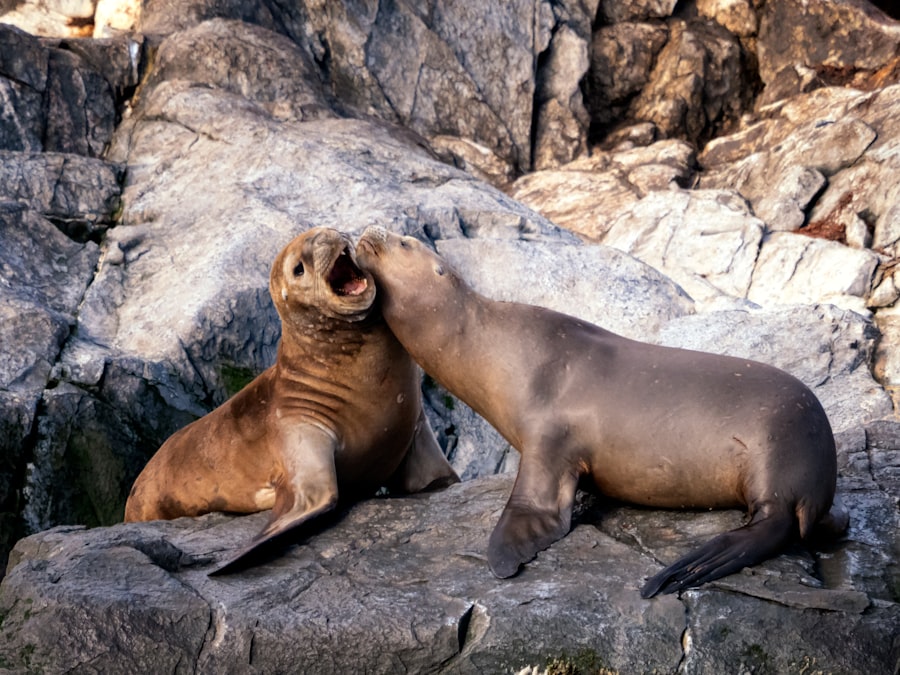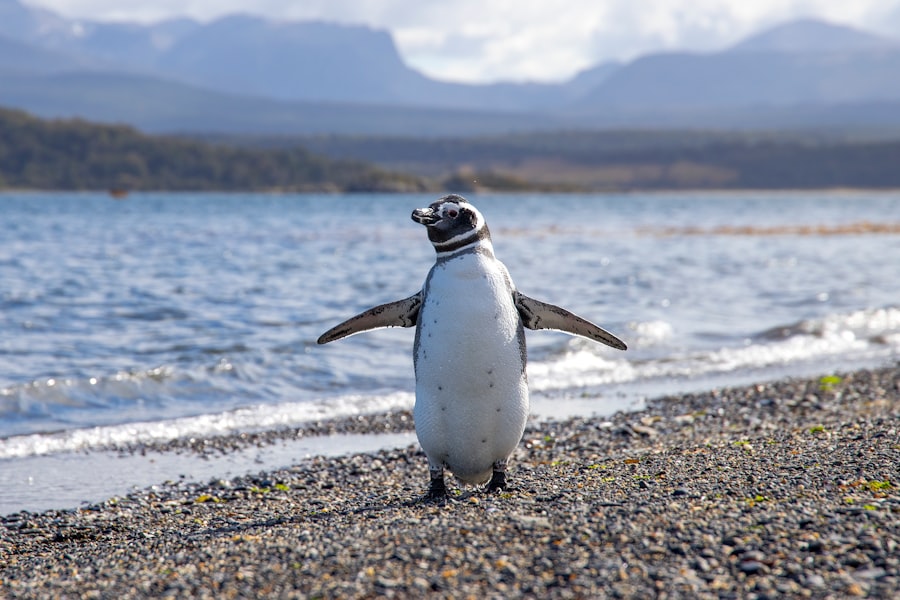The Drake Passage, a body of water that separates South America from Antarctica, is renowned for its tumultuous seas and unpredictable weather. Stretching approximately 600 miles, it serves as a critical maritime route for vessels traveling to and from the Antarctic region. The passage is named after Sir Francis Drake, the English explorer who navigated these waters in the late 16th century.
Its significance lies not only in its geographical position but also in its role as a conduit for ocean currents, which influence global climate patterns. The waters of the Drake Passage are often characterized by their rough conditions, making it a formidable challenge for sailors and adventurers alike. In contrast, the Beagle Channel, located to the south of the Drake Passage, offers a more sheltered route for navigation.
This narrow strait runs between the southern tip of South America and the islands of Tierra del Fuego, providing a picturesque passage that is rich in biodiversity. Named after the HMS Beagle, the ship that carried Charles Darwin on his famous voyage, the channel is dotted with islands and islets, each with its own unique ecosystem. The Beagle Channel is not only a vital shipping route but also a popular destination for tourists seeking to explore its stunning landscapes and diverse wildlife.
Key Takeaways
- The Drake Passage is a narrow body of water between South America’s Cape Horn and the South Shetland Islands of Antarctica, while the Beagle Channel is a natural waterway in the archipelago of Tierra del Fuego.
- When planning a journey through the Drake Passage and Beagle Channel, it is important to consider the best time of year to travel, as well as the availability of experienced guides and suitable vessels for the trip.
- Navigational challenges in the Drake Passage include strong winds, unpredictable currents, and icebergs, requiring careful route planning and constant monitoring of weather and sea conditions.
- Weather in the Drake Passage and Beagle Channel can be harsh and rapidly changing, with strong winds, rough seas, and low temperatures, making it essential to be prepared for challenging conditions.
- Wildlife encounters in the Drake Passage and Beagle Channel are a highlight of the journey, with opportunities to see various species of whales, seals, penguins, and other seabirds in their natural habitat.
Planning your journey through the Drake Passage and Beagle Channel
Planning a journey through the Drake Passage and Beagle Channel requires careful consideration of various factors, including timing, vessel choice, and itinerary. The best time to embark on this adventure is during the austral summer months, from November to March, when weather conditions are generally more favorable. Travelers should research different cruise lines and expedition companies that specialize in Antarctic voyages, as they often provide tailored experiences that cater to various interests, from wildlife watching to photography.
It is essential for travelers to prepare adequately for the journey ahead. This includes packing appropriate clothing for varying weather conditions, as temperatures can fluctuate dramatically. Layering is key, as it allows individuals to adjust their attire based on changing temperatures and wind conditions.
Additionally, travelers should familiarize themselves with the itinerary and any planned excursions, ensuring they make the most of their time in this remarkable region. Engaging with fellow travelers and sharing experiences can also enhance the journey, creating lasting memories and friendships.
Navigational challenges and considerations in the Drake Passage

Navigating the Drake Passage presents a unique set of challenges that require skill and experience. The passage is notorious for its strong currents and high winds, which can create steep waves and rough seas. Mariners must be well-versed in their vessel’s capabilities and equipped with advanced navigational tools to ensure safe passage.
Understanding the intricacies of tidal patterns and weather forecasts is crucial for avoiding potentially hazardous conditions. Moreover, the presence of icebergs and floating debris adds another layer of complexity to navigation in these waters. Sailors must remain vigilant and maintain a safe distance from ice formations while also being prepared to alter their course if necessary.
The unpredictable nature of the Drake Passage means that even seasoned sailors must exercise caution and adaptability throughout their journey.
Weather and sea conditions in the Drake Passage and Beagle Channel
| Location | Temperature (Celsius) | Wind Speed (km/h) | Wave Height (meters) |
|---|---|---|---|
| Drake Passage | 2 | 40 | 4 |
| Beagle Channel | 5 | 30 | 2 |
The weather in the Drake Passage can be highly variable, with conditions changing rapidly from calm to stormy within a matter of hours. The region is influenced by the confluence of several ocean currents, which can lead to sudden shifts in temperature and wind patterns. Travelers should be prepared for everything from sunny skies to heavy rain and strong winds.
It is advisable to monitor weather forecasts closely before and during the journey to ensure safety and comfort. In contrast, the Beagle Channel generally experiences milder weather conditions due to its sheltered location. While storms can still occur, they are typically less severe than those found in the Drake Passage.
The channel’s unique geography creates a microclimate that supports lush vegetation and diverse wildlife. Travelers can expect more stable weather patterns here, making it an ideal location for exploration and outdoor activities.
Wildlife encounters in the Drake Passage and Beagle Channel
One of the most captivating aspects of traveling through the Drake Passage and Beagle Channel is the opportunity to encounter a diverse array of wildlife. The waters are home to various species of marine life, including seals, whales, and seabirds. The passage is particularly famous for its sightings of humpback whales, orcas, and minke whales during migration seasons.
Observing these magnificent creatures in their natural habitat is a highlight for many travelers. The Beagle Channel also boasts rich biodiversity, with opportunities to see penguins, sea lions, and numerous bird species such as albatrosses and cormorants. The islands along the channel provide nesting grounds for many seabirds, making it a prime location for birdwatching enthusiasts.
Travelers are often encouraged to bring binoculars and cameras to capture these unforgettable moments while respecting wildlife guidelines to ensure minimal disturbance to these animals.
Safety precautions and emergency procedures in the Drake Passage and Beagle Channel

Safety should always be a top priority when navigating through the Drake Passage and Beagle Channel. Travelers are advised to familiarize themselves with emergency procedures outlined by their cruise or expedition company before setting sail. This includes understanding evacuation routes, life jacket protocols, and communication systems on board.
Crew members are typically trained in emergency response techniques, ensuring that passengers are well-informed about safety measures. Additionally, travelers should be aware of their surroundings at all times, especially during rough sea conditions. It is essential to follow crew instructions regarding movement on board during turbulent weather and to secure personal belongings to prevent accidents.
By remaining vigilant and prepared for unexpected situations, travelers can enhance their safety while enjoying this remarkable journey.
Historical significance and exploration of the Drake Passage and Beagle Channel
The historical significance of the Drake Passage and Beagle Channel cannot be overstated. The passage has long been a critical route for explorers seeking to navigate between the Atlantic and Pacific Oceans. Sir Francis Drake’s expeditions in the late 16th century marked one of the first European encounters with these waters, paving the way for future exploration.
The Beagle Channel also holds historical importance due to its association with Charles Darwin’s voyage aboard the HMS Beagle in the 1830s. Darwin’s observations during this journey contributed significantly to his theories on evolution and natural selection. The channel’s unique ecosystems provided him with invaluable insights into biodiversity that continue to influence scientific thought today.
Cultural and indigenous perspectives of the Drake Passage and Beagle Channel
The cultural significance of the Drake Passage and Beagle Channel extends beyond their geographical features; they are also deeply intertwined with indigenous histories. The region has been inhabited by various indigenous groups for thousands of years, including the Yaghan people who have lived along the shores of Tierra del Fuego. Their rich cultural heritage includes traditional practices related to fishing, hunting, and navigation that have been passed down through generations.
Understanding these indigenous perspectives adds depth to any journey through these waters. Travelers are encouraged to engage with local communities respectfully, learning about their customs and traditions while acknowledging their historical connection to this remarkable landscape. This cultural exchange enriches the travel experience and fosters greater appreciation for the region’s history.
Recommended routes and landmarks in the Drake Passage and Beagle Channel
When planning a journey through the Drake Passage and Beagle Channel, several recommended routes offer breathtaking views and unique landmarks worth exploring.
” This iconic landmark represents a significant point in maritime history where sailors have faced treacherous conditions for centuries. Another notable destination within the Beagle Channel is Puerto Williams, a small town on Navarino Island that serves as a gateway to various outdoor adventures such as hiking, kayaking, and wildlife watching.
Travelers may also wish to explore nearby islands like Isla de los Estados (Staten Island), which boasts stunning landscapes and rich biodiversity.
Tips for a comfortable and enjoyable journey through the Drake Passage and Beagle Channel
To ensure a comfortable journey through these challenging waters, travelers should consider several practical tips. First and foremost, investing in high-quality waterproof gear is essential for staying dry during unpredictable weather conditions. Comfortable footwear is also crucial for exploring both onboard activities and shore excursions.
Additionally, maintaining an open mind about potential sea sickness can enhance overall enjoyment of the trip. Many travelers find relief through over-the-counter medications or natural remedies such as ginger or acupressure bands. Staying hydrated and consuming light meals can also help mitigate discomfort during rough seas.
Exploring nearby attractions and destinations beyond the Drake Passage and Beagle Channel
Beyond the breathtaking landscapes of the Drake Passage and Beagle Channel lie numerous attractions waiting to be explored. For those venturing further south into Antarctica, opportunities abound for adventure activities such as ice climbing, polar plunges, or even camping on ice floes under starry skies. For travelers looking to explore more of South America after their journey through these waters, destinations like Ushuaia—the southernmost city in the world—offer rich cultural experiences alongside stunning natural beauty.
Visitors can explore Tierra del Fuego National Park or embark on scenic hikes that showcase breathtaking vistas. In conclusion, navigating through the Drake Passage and Beagle Channel presents an extraordinary opportunity for adventure seekers eager to explore one of Earth’s most remote regions. With careful planning, respect for local cultures, awareness of safety protocols, and an appreciation for wildlife encounters, travelers can create unforgettable memories while traversing these iconic waterways.
The Drake Passage and the Beagle Channel are two significant waterways in the Southern Hemisphere, each offering unique challenges and breathtaking views for explorers and travelers. The Drake Passage, known for its turbulent waters, serves as a gateway to Antarctica, while the Beagle Channel, named after the HMS Beagle, offers a more sheltered route through the Tierra del Fuego archipelago. For those interested in learning more about these fascinating regions and their geographical significance, you can explore a related article on MyGeoQuest, which provides insights into the natural wonders and historical importance of these waterways.
WATCH NOW! Drake Passage: Earth’s Deadliest Waters Revealed
FAQs
What is the Drake Passage?
The Drake Passage is the body of water between the southern tip of South America and the South Shetland Islands of Antarctica. It connects the southwestern part of the Atlantic Ocean with the southeastern part of the Pacific Ocean.
What is the Beagle Channel?
The Beagle Channel is a natural waterway in the archipelago of Tierra del Fuego, in the extreme southern part of South America. It separates the main island of Tierra del Fuego from various smaller islands, and connects the Atlantic and Pacific Oceans.
What is the significance of the Drake Passage and Beagle Channel?
The Drake Passage and Beagle Channel are important navigational routes for ships traveling between the Atlantic and Pacific Oceans, particularly for vessels heading to and from Antarctica. They also offer stunning natural scenery and wildlife viewing opportunities for tourists and researchers.
What is the weather like in the Drake Passage and Beagle Channel?
The weather in the Drake Passage and Beagle Channel can be harsh and unpredictable, with strong winds, rough seas, and rapidly changing conditions. The area is known for its challenging sailing conditions, often referred to as the “Roaring Forties” and “Furious Fifties” due to the strong westerly winds.
What wildlife can be found in the Drake Passage and Beagle Channel?
The region is home to a diverse array of wildlife, including seabirds, penguins, seals, and whales. It is a popular destination for wildlife enthusiasts and birdwatchers due to the abundance of marine life and bird species that can be observed in the area.
